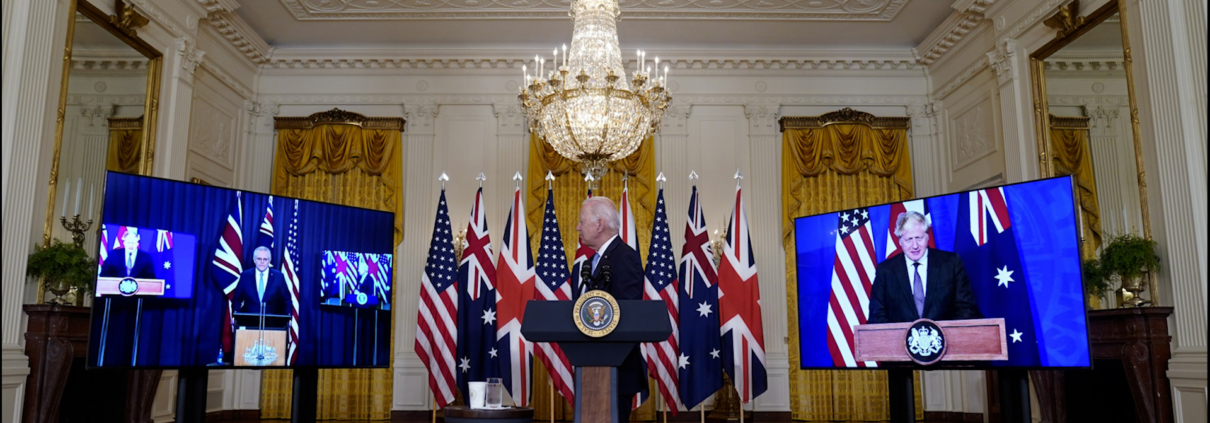The new trilateral security pact between Australia, the United Kingdom, and the United States — known as AUKUS — is sending ripples across the world. The primary objective of this coalition is to help Australia build a fleet of nuclear-powered submarines, alongside secondary objectives to enhance cooperation in defence-related areas, such as cyber warfare, quantum computing, and underwater technologies.
Beneath the surface, however, AUKUS is an anti-China alliance geared towards balancing power in the Indo-Pacific. The members have taken stock of China’s increasing presence in the Indian Ocean — establishment of China’s naval base in Djibouti, transgressions in the South China Sea, debt-trap diplomacy in Sri Lanka, etc. — and are hoping to secure their interests. AUKUS signals the translation of anti-China consensus into concrete actions. I believe this is a strong statement because the US has been historically conservative with the sharing of military intelligence. The nuclear propulsion tech was thus far shared only with the UK, with Australia now becoming privy to it. So, what do these developments mean for another important stakeholder in the Indo-Pacific, India?
India: Non-partisan yet important to AUKUS’ external dynamics
The US has clarified that India and Japan will not be part of AUKUS. However, both Japan and India have taken a largely welcoming stance towards the pact, clearing diplomatic hurdles for the success of AUKUS. This was possible due to QUAD, which is a non-military alliance between the US, India, Australia, and Japan, created for the same purpose of countering China, but through soft-power diplomacy. Both AUKUS and QUAD, with their shared objective, could complement each other, working wonders for India. Multiple factors support this notion.
First, Australia has great geopolitical prominence in the Indo-Pacific. In recent years, it has taken a strong stance against Chinese affairs, through trade snubs, financial regulations, etc. But to safeguard its territorial integrity, Australia needed maritime defence reinforcements, which AUKUS will enable. In doing so, it will empower Australia — a strategic partner of India and a QUAD member — to tilt the Indo-Pacific power balance in favour of anti-China countries. Considering Australia is set to invest $100 billion in India by 2035, these developments are consistent with long-term strategic relations between the two nations.
Scope for Indo-French relations
On the other hand, France has deemed AUKUS as a “betrayal” on Australia’s part, as the alliance led to the scrapping of an existing submarine deal between both nations. Although aligned with the anti-China sentiment, France had its own ambitions in the Indo-Pacific. So, Australia, in a bid to pacify France, could form another parallel strategic alliance with it, making room for India to join. This is a strong possibility on the back of France’s strong bilateral relations with India (the Rafale deal being a case in point).
Also, the political pressure introduced by AUKUS gives India the leverage in any potential deal with France, which will assist India’s ambitions of building indigenous nuclear-powered ballistic missile submarines. I believe it’s a win-win situation for both countries. India can develop nuclear-powered submarines using France’s help and simultaneously reduce reliance on Russia; while France can make a grand re-entry into the Indo-Pacific geopolitics. Also, from a purely technical standpoint, France’s low-enriched uranium (LEU) fuel-based naval reactors have intrinsic advantages over the US high-enriched uranium ones.
So, contrary to the opinion of a few in India, there is no fear-of-missing-out from AUKUS. India has an existing nuclear submarine program, and AUKUS will help Australia get its first-ever nuclear submarines. If anything, in light of India’s continued problems with China, any action intended to tame the dragon is advantageous to India. From this perspective, AUKUS is both timely and much-needed.
https://www.dfat.gov.au/geo/india/ies/overview.html



